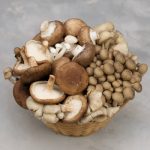By David Blyweiss, M.D., Advanced Natural Wellness
Mushrooms are a staple in my kitchen. I toss them in my omelets and frittatas, put them in soups, stews and stir fries, add them to salads and veggie wraps, use them as a topping on meats and fish.
But I’m in the minority here.
As it turns out, the average American only eats about four pounds of mushrooms over the course of an entire year. That’s a paltry amount when you compare it to the 22+ pounds the average person in China consumes each year.
That’s a shame, because in addition to nutrients like potassium, copper, selenium, zinc, vitamin D and the B vitamins, mushrooms contain some very special compounds that make them an extremely powerful superfood.
Specifically, mushrooms are the most abundant source of ergothioneine (ergo) in our food supply. This is a super-antioxidant.
Ergo is a powerhouse when it comes to protecting your DNA and powering up your mitochondria for life-long health and energy. It’s a powerful free radical scavenge. It’s an anti-inflammatory. It protects against radiation and aging.
But that’s just the beginning of the unique nutrient profile of mushrooms.
Turn on Your Master Antioxidant
Another powerful antioxidant in mushrooms is glutathione. It’s called the “master antioxidant” because it helps your body regenerate other antioxidants. It also neutralizes free radicals and, like ergo, it’s great at protecting your DNA and mitochondria.
Plus, both ergo and glutathione have chelation activity that helps remove heavy metals like mercury (from top of the food chain fish like tuna and swordfish) and cadmium (cigarette smoke and contaminated soil) from your body.
But the benefits don’t stop there.
Mushrooms have another thing going for them. They are loaded with beta-glucans. This is a type of soluble fiber that has been gaining a great deal of attention in recent years. And for good reason!
Beta-glucans stimulate the immune system by acting as prebiotics for your gut microbiome. They help promote the health of the intestinal bugs that make up 70% of your immune system. And as a regular Advanced Natural Wellness reader, you know how important your gut microbes are when it comes to protecting against disease.
The Incredibly Tasty and Healthy Fungus Among Us
I think it’s a tragedy that so many people only eat mushrooms on their pizzas, cheeseburgers and Philly cheese steak sandwiches when there are so many healthier ways to enjoy them.
Personally, I’ll take them anyway I can, because they taste great and the unique nutrient profile of mushrooms offers so many health benefits.
They help boost your immune system. They are anti-inflammatory and reduce the risk of certain cancers. Mushrooms can protect against diabetes and reduce the risk of heart disease. They can even help with neurological issues like cognitive decline and Parkinson’s.
And there are so many other ways to eat them!
In addition to using them as toppers and complementary additions to your meals, they can actually be the STAR of your lunch or dinner. They can be grilled, stuffed, baked, broiled or marinated as an entree. Or you can use them to make mushroom soup, mushroom casserole, mushroom marinara or mushroom hummus…sounds like Forrest Gump’s Bubba discussion on how many ways to eat shrimp.
The possibilities are endless!
For the highest ergothioneine content go for the exotics. Shiitake, oyster, maitake and king oyster mushrooms all have higher amounts ergothioneine than white button, cremini and portabella mushrooms. These mushrooms also generate the most Vitamin D when placed in the midday sun for at least 15 minutes.
But portabellas and creminis still have a great ergothioneine profile, followed closely by white buttons. So mix them up and enjoy a wide variety of mushrooms with your meals.
Just don’t forget to buy organic whenever possible.
SOURCES:
A Growing Demand for the Fungus Among Us. Gro Intelligence. News Article 2017.
Mushroom Market Size, Share & Trends Analysis Report By Product (Button, Shiitake, Oyster), By Form, By Distribution Channel, By Application (Food, Pharmaceuticals, Cosmetics), By Region, And Segment Forecasts, 2022 – 2030. Grand View Research. Copyright © 2022.
Paul BD, Snyder SH. The unusual amino acid L-ergothioneine is a physiologic cytoprotectant. Cell Death Differ. 2010 Jul;17(7):1134-40.
Cheah IK, Halliwell B. Ergothioneine, recent developments. Redox Biol. 2021 Jun;42:101868.
Kalaras MD, Richie JP, Calcagnotto A, Beelman RB. Mushrooms: A rich source of the antioxidants ergothioneine and glutathione. Food Chem. 2017 Oct 15;233:429-433.
Fu TT, Shen L. Ergothioneine as a Natural Antioxidant Against Oxidative Stress-Related Diseases. Front Pharmacol. 2022 Mar 18;13:850813.
Jozefczak M, Remans T, Vangronsveld J, Cuypers A. Glutathione is a key player in metal-induced oxidative stress defenses. Int J Mol Sci. 2012;13(3):3145-3175.
Akramiene D, Kondrotas A, Didziapetriene J, Kevelaitis E. Effects of beta-glucans on the immune system. Medicina (Kaunas). 2007;43(8):597-606.
Feeney MJ, Dwyer J, Hasler-Lewis CM, Milner JA, Noakes M, Rowe S, Wach M, Beelman RB, Caldwell J, Cantorna MT, Castlebury LA, Chang ST, Cheskin LJ, Clemens R, Drescher G, Fulgoni VL 3rd, Haytowitz DB, Hubbard VS, Law D, Myrdal Miller A, Minor B, Percival SS, Riscuta G, Schneeman B, Thornsbury S, Toner CD, Woteki CE, Wu D. Mushrooms and Health Summit proceedings. J Nutr. 2014 Jul;144(7):1128S-36S. Halliwell B, Cheah IK, Tang RMY. Ergothioneine – a diet-derived antioxidant with therapeutic potential. FEBS Lett. 2018 Oct;592(20):3357-3366.



